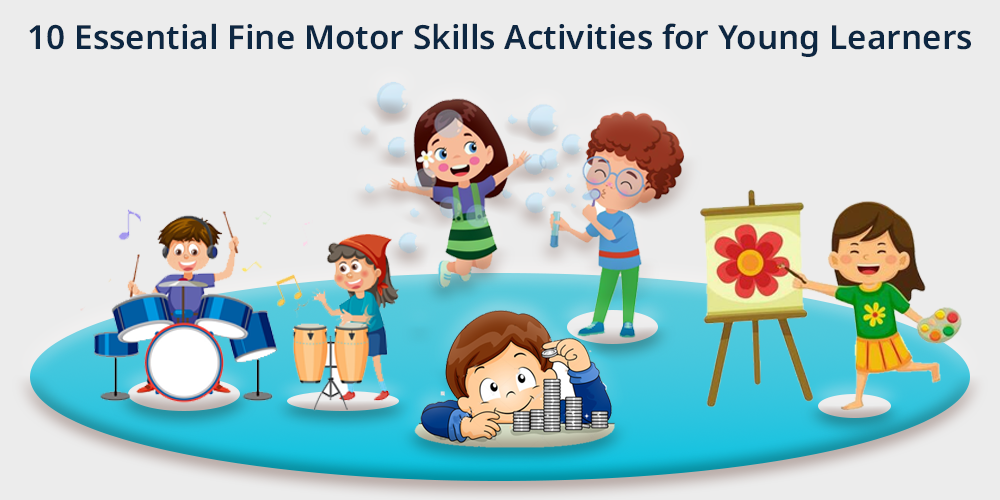
As toddlers grow, they develop motor skills. Motor skills are the ability of small kids to do small activities that help in developing fine motor skills among children.
Parents can help to develop fine motor skills among children by promoting activities that will help to develop the coordination of muscles among them. Fine motor skills also develop critical thinking abilities among students.
It’s natural for kids to develop fine motor skills on their own, but if children struggle with developing fine motor skills, then they have difficulty doing daily tasks.
Children with difficulty in developing fine motor skills will struggle with small tasks such as using tools like scissors, moving objects with their fingertips, and gripping utensils like pencils etc.
Parents and caregivers can enhance fine motor skills in children by promoting various activities such as drawing, gardening, painting, music, and small day-to-day tasks etc. Small tasks will help children develop gross as well as fine motor skills.
Contents
What are Fine Motor Skills?
Fine motor skills are the ability of kids to do small, precise movements with their hands, fingers, feet, and toes. It is a coordination of muscle movement and joints.
Fine motor skills are important among kids to promote all-around development and give them independence to do things such as eating by hand, dancing, arts and crafts, feeding, and so on.
The best way to develop fine motor skills among students is to promote activities in their daily schedules. Fine motor skills are a detailed process that requires awareness, coordination of muscles and movements, sensitivity of finger tips, precision, etc.
Sometimes, children face difficulties in developing fine motor skills, which slows their development.
Healthcare experts also say that improperly developing fine motor skills in children will create hindrances in other areas of development, such as cognitive development, physical development, social development, emotional development, etc.
How to Develop Fine Motor Skills Among Children’s
Fine motor skills are essential for kids to promote holistic development. By doing various activities, children can develop their fine motor skills. Parents can also notice small things to understand whether they are doing all the activities perfectly or having some difficulties. By promoting fine motor skills, children can enhance their fine motor skills.
Parents can also check online learning strategies to develop motor skills in children. This will help parents learn about the activities that will help in developing fine motor skills in children
Below, you can check the activities through which you can judge the fine motor skills among kids.
1. Peeling Stickers:
At the initial stages, children peel stickers from clothes or books and place them in other places. This is the initial part of fine motor skills.
Parents can enhance their skills by giving some activities, such as drawing a circle on white paper, and a child to place the sticker inside the circle. This will help to understand the visual motor coordination by placing a sticker inside a target.
2. Drawing and Painting:
Painting is one of the best ways to develop motor skills among kids. Painting and drawing help to understand the muscle movement and coordination among children.
As a parent, it is essential to encourage children to do various types of paintings and drawings, as this will help in strengthening a child’s hand-eye coordination.
Holding brushes and crayons will enhance the grip of the fingertips and help kids learn about the control and sensory parts.
3. Lacing and Threading:
Lacing and threading are one of the major parts of fine motor skills activities in childhood. Lacing and threading help in promoting bilateral coordination and integration among children and also enhance concentration levels.
Beads into threads will help in developing fine motor movement, which is essential for fine motor skills. Parents should give children beads and threads in which kids will insert threads or laces that will help them to adapt to smaller things.
This will enhance their finger grip and concentration levels among them.
Also Read, How to concentrate on studies ?
4. Sorting Coins:
Sorting coins is one effective way to strengthen the finger tips and muscle movements. Through coins, children can also learn about different sizes and numbers, which helps them to understand the differences.
To promote fine motor skills through the coin-spreading activity, parents can place several coins of different sizes on a box or a table and ask their child to arrange them according to different sizes and numbers.
This will promote critical thinking ability among children and also help in developing cognitive development of children.
5. Bubble:
Blowing is everyone’s favorite, especially for kids. Blowing bubbles and popping them also helps in developing fine motor skills. As a child, you can help to develop fine motor skills through bubbling activities.
For example, blow a bubble and ask your kid to pop the bubble as much as possible. Will help in developing sensory effects in finger tips and promote their motor activity.
Through this, children also enhance their focus and consistency for a long period of time.
6. Ripping and Tearing Paper:
Ripping and crumbling paper is one of the most effective ways to promote fine motor skills among kids. This type of activity helps in strengthening the muscles of the hands and fingers.
Through tearing paper, children can develop grip muscles and strength. As a parent, don’t stop your kid from tearing papers or crumbling them; instead, give them old newspapers to tear.
The activity of tearing paper will promote the use of tripod grasps. Hence, it develops the process of combining grips.
7. Pickup sticks:
Pickup sticks is a classic game that promotes finger isolation among students. In it, children have to pick sticks one by one without moving the other sticks.
These children should use all fingers and enhance there finger movements. This strengthens their finger muscles and nerve reflexes and is also known for developing thinking skills.
8. Cutting with Scissors:
Using scissors to cut out shapes is one of the aspects of fine motor skills. Holding scissors and cutting down shapes helps in enhancing hand movements and finger correlation.
This also helps in developing fine muscles and concentration among children. To enhance fine motor skills, parents can give them scissors and a piece of paper and ask them to cut the required shape.
This will help kids to enhance sensory effects and boost their learning abilities.
9. Gardening:
Gardening and planting trees are effective ways of developing fine motor skills among children. Children who dig soil and plant help them to develop gross motor skills. This also enables hand-eye coordination among children.
This enables children to use pincer grasps while planting seeds and trees. Parents can encourage this skill by promoting gardening activities.
Get your children to plant seeds, dig soil, and do gardening; this will enhance their fine motor skills as well as gross motor skills.
10. Playing Instruments:
Playing instruments such as the flute, drums, and casio helps in developing fine motor skills in children.
Through instruments, kids develop their muscle memory and strengthen the muscles of the hands and fingers. It also enhances their cordial reflex and boosts their learning resilience.
As a parent, you can encourage them to learn to play instruments such as the flute, drums, piano, etc. This will promote smooth motor skills among children.
Conclusion
Children’s overall development and independence depend heavily on the development of their fine motor skills.
Participating in a range of activities like sorting coins, painting, lacing, peeling, and playing musical instruments can greatly improve their focus, hand-eye coordination, and muscle strength.
These activities give children the chance to practice and hone their skills, and parents and other caregivers are essential in making this happen.
We can assist children in overcoming fine motor development obstacles and ultimately promote their cognitive, physical, social and emotional development by creating an atmosphere that values creativity and exploration.


